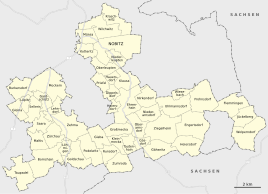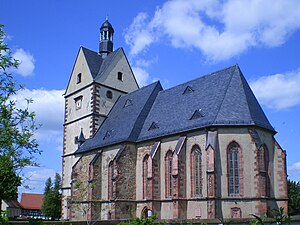Brick home
|
Brick home
community Nobitz
|
|
|---|---|
| Coordinates: 50 ° 55 ′ 33 ″ N , 12 ° 33 ′ 12 ″ E | |
| Height : | 220 m |
| Area : | 17.35 km² |
| Residents : | 826 (December 31, 2016) |
| Population density : | 48 inhabitants / km² |
| Incorporation : | 6th July 2018 |
| Postal code : | 04603 |
| Primaries : | 034494, 037608 (southern part of Engertsdorf) |
|
Location of Ziegelheim in the unified municipality of Nobitz
|
|
Ziegelheim is a district of the municipality Nobitz in the Altenburger Land district in Thuringia .
Until 2018 the place was an independent municipality with four districts. Since then, only the districts of Uhlmannsdorf and Thiergarten belong to the district of Ziegelheim , while the three former districts of Engertsdorf , Gähsnitz and Niederarnsdorf are now districts of the municipality of Nobitz. Due to its historical affiliation to the Ziegelheim manor , the main town of Ziegelheim belonged to Saxony until 1952 .
geography
Location and traffic
The place and its corridor are located in Altenburg's redeemed hill country south of the Leinawald and Altenburg. The national highway 180 affected south-west the room. With district roads 202 and 203 the community is opened up to traffic.
Neighboring places
| Niederarnsdorf | Uhlmannsdorf | |
| Oberarnsdorf |

|
Thiergarten , Engertsdorf |
| Gähsnitz | Heiersdorf |
Adjacent places of the former municipality of Ziegelheim are (clockwise) Frohnsdorf , Göpfersdorf , the city of Waldenburg ( district of Zwickau ), Oberwiera (district of Zwickau), Nobitz and Langenleuba-Niederhain .
Local division
The municipality of Ziegelheim was made up of the districts of Ziegelheim, Engertsdorf , Gähsnitz and Niederarnsdorf , with the district of Engertsdorf consisting of the formerly independent communities of Engertsdorf (formerly Hinteruhlmannsdorf) and Heiersdorf . Only the Thiergarten and Uhlmannsdorf locations still belong to today's Nobitz district of Ziegelheim .
history
12th to 18th centuries
The founding of Ziegelheim and its first church can be assumed to have occurred between 1170 and 1200. Ziegelheim was first mentioned in a document on March 23, 1254 with a Hugo, pastor of Ziegelheim. In the certificate of mention it says: "Hugo plebanus de cygilheim". Accordingly, there was already a church in the place at that time, which is why the place is probably a few generations older. The Ziegelheim manor and the “de Cigilheim” family were proven to be a manor in 1261. The castle complex, built as a dry fortification, was located north of the churchyard. After the noble family von Ziegelheim died out in the middle of the 14th century, the manor was dissolved in the 15th century. The castle tower was converted into a church tower.
The Ziegelheim Vorwerk , which is already mentioned in 1435 as a widow's residence and personal property, was of further importance for the Ziegelheim manor . At that time, Ziegelheim was in the hands of the Lords of Schönburg as a Wettin - Saxon fiefdom . To the Vorwerk Ziegelheim belonged the places Ziegelheim (with the Saxon parts of Frohnsdorf and Heiersdorf), Thiergarten, Niederarnsdorf and Uhlmannsdorf.
With the marriage of Ernst I von Schönburg (around 1458–1489) and Anna von Rieneck (1458–1525), the bride received the brick home and the associated villages as personal items in 1480. After the death of her husband in 1489, she officially became a widow's residence in Ziegelheim as the Vorwerk of Waldenburg Castle , which she probably never lived in. The construction of the Marien-Pilgrimage Church on a hill in the east of the village took place in the 45 years of their possession of Ziegelheim . This stone church, built between 1507 and 1518, replaced a smaller wooden pilgrimage church on a pilgrimage route that contained a statue of the Virgin Mary as a shrine. In addition to Ziegelheim, the parish Ziegelheim in the Superintendentur Waldenburg also included Niederarnsdorf, Thiergarten, Uhlmannsdorf and a portion of Heiersdorf (Hoyersdorf) as well as the subsidiary church in Franconia . On December 13, 1525 Anna "Gratiosa" von Schönburg died, whereby the personal property and the widow's residence Ziegelheim with the associated villages fell back to the Schönburg family.
Ziegelheim was the main town of the Ziegelheim manor , which was owned as a Saxon fief by the Lords of Schönburg ( Schönburg-Waldenburg line ). The Dingstuhl Ziegelheim included the places Ziegelheim with one estate in Frohnsdorf and two estates in Heiersdorf (historically referred to as Hoyersdorf or Heuersdorf), Thiergarten, Uhlmannsdorf, Niederarnsdorf and Gähsnitz (Saxon share).
19th century
After 1813, the Ziegelheim patrimonial court was administered by the Schönburg Justice Office in Remse . The relationship between the Kingdom of Saxony and the House of Schönburg was reorganized in 1835. The Schönburg-Waldenburg areas, which were under Saxon feudal rule, such as the Remse rule and the Ziegelheim manor, were placed under the administration of the Zwickau Royal Saxon Office . On September 25, 1856, the judicial powers of the Ziegelheim manor, as well as those of the Remse manor, were ceded to the Saxon state. Since then, until the reorganization of the administration in the Kingdom of Saxony in 1875, Ziegelheim was administered by the Remse court office. From 1875, the places of the former lordship of Ziegelheim belonged to the Zwickau administration . After an administrative reform was carried out in the area of the Schönburg recession in 1878, they came with the entire former judicial district of Remse in 1880 to the newly founded Saxon governorate of Glauchau . Thiergarten was incorporated into Ziegelheim in 1893 and then merged into Ziegelheim.
20th century
During the negotiations of the German Reichstag about an exchange of territory and a border adjustment between the Free State of Saxony and the State of Thuringia in 1928, today's municipality of Ziegelheim was particularly affected. In the Thuringian-Saxon State Treaty of December 7, 1927, the territories that changed countries were set in advance. The draft law dates from March 15, 1928. As a result, the Saxon parts of Frohnsdorf and Heiersdorf, which had previously belonged to Ziegelheim and whose parcels were enclosed as exclaves of Thuringian territory, were given to Thuringia and united with the respective Thuringian places in the Altenburg district . In return, the previous Thuringian enclaves of Jesenitz were merged with the Saxon Gähsnitz. The rest of the boundaries of today's municipality remained unchanged.
On July 1, 1950 Uhlmannsdorf and Niederarnsdorf were incorporated into Ziegelheim on the Saxon side. The Thuringian villages Hinteruhlmannsdorf and Heiersdorf were merged on the same day to form the new community Engertsdorf , the district Hinteruhlmannsdorf has since been given the name Engertsdorf assigned to the community . The new place name was given in honor of the communist resistance fighter Otto Engert , who was executed on January 11, 1945 in Dresden. As a result of the second district reform in the GDR , the communities of Ziegelheim and Gähsnitz came to the former Thuringian district of Altenburg on July 25, 1952 , which was assigned to the Leipzig district , which otherwise consisted of former Saxon areas . Gähsnitz was incorporated into Ziegelheim on January 1, 1957 and Engertsdorf on January 1, 1973. The municipality of Ziegelheim thus also comprised districts that were historically part of Thuringia. Since 1990, Ziegelheim has belonged to the Altenburg district in Thuringia, which was added to the Altenburger Land district in 1994.
With the incorporation of the communities of Ziegelheim and Frohnsdorf into the large community of Nobitz on July 6, 2018, the historical boundaries of the former lordship of Ziegelheim disappeared completely. They are now only recognizable in the fact that the Protestant parishes of Ziegelheim (with Uhlmannsdorf and Niederarnsdorf), Oberwiera (with Gähsnitz) and Niederwiera (with Heiersdorf) belong to the Evangelical Lutheran Church of Saxony , since the area looks like a wedge to the north in the Evangelical Church in central Germany belonging church district Altenburger Land protrudes into it.
Incorporations
Thiergarten was incorporated into Ziegelheim in 1893. This was followed on July 1, 1950 by Niederarnsdorf and Uhlmannsdorf, and on January 1, 1957, by Gähsnitz. The community Engertsdorf, which was formed on July 1, 1950 from the communities Hinteruhlmannsdorf and Heiersdorf, was incorporated into Ziegelheim on January 1, 1973.
On July 6, 2018, Ziegelheim was incorporated into the municipality of Nobitz, whereby the former municipality forms the four Nobitz districts of Ziegelheim (with Uhlmannsdorf and Thiergarten), Niederarnsdorf, Gähsnitz and Engertsdorf (with Heiersdorf).
Population development
Development of the population (as of December 31st) :
|
|
|
|
- Data source: Thuringian State Office for Statistics
politics
mayor
The mayor was Hans-Jürgen Kasper from 1994 to 1999. Mario Rohr had been the incumbent since the election on June 13, 1999. He last ran for office on June 5, 2016 on the CDU list and was confirmed in office with a majority of 78.6% without opposing candidates and a turnout of 19.4% (- 0.5% p).
Municipal council
Since the local elections on May 25, 2014 , the local council has been composed as follows:
- Fire department - 3 seats (43.7%)
- Country sports club - 3 seats (31.4%)
- CDU - 2 seats (24.9%)
The turnout was 47.9%.
Personalities
- Heinz Wildenhain (born December 11, 1927 in Uhlmannsdorf), former SED politician
Say
The "Ziegelheimer Ghost Story" from 1689 was handed down in Ziegelheim.
literature
- Richard Steche : Ziegelheim. In: Descriptive representation of the older architectural and art monuments of the Kingdom of Saxony. 13. Issue: Glauchau District Authority . CC Meinhold, Dresden 1890, p. 43.
Web links
- Ziegelheim in the Digital Historical Directory of Saxony
- Website of the pilgrimage church St. Marien Ziegelheim
Individual evidence
- ^ Description of Ziegelheim on wikisource
- ↑ Ziegelheim on www.total-lokal.de
- ↑ Anna von Rieneck in the Saxon Biography
- ↑ Werner Herrmann. Dorfkirchen in Thüringen Verlagshaus Thuringia, 1992, ISBN 3-86087-014-9 , S91
- ↑ Description of the superintendent Waldenburg in the archive of the Free State of Saxony
- ^ Description of the parish of Ziegelheim, p. 320
- ↑ History of Anna "Gratiosa" of Schoenburg on www.ziegelheim.de
- ↑ The Ziegelheim manor in the “Monograph on the princely and counts house Schönburg”, p. 51
- ^ Components of the Remse Justice Office in the "Handbuch der Geographie", p. 410
- ^ The Schönburg rule of Waldenburg in the archive of the Free State of Saxony
- ↑ Incorporation of the Remse rule with the Tirschheim and Ziegelheim dinghies in the Zwickau district directorate, “Handbook of the royal Saxon legislation of January 28th and 30th, 1835”, p. 132
- ^ The Ziegelheim court as part of the Zwickau office in the book "Geography for all Stands, p. 635"
- ↑ Ziegelheim in the "Handbuch der Geographie", p. 149
- ^ The Zwickau Office in the Archives of the Free State of Saxony
- ↑ The Glauchau administrative authority in the municipal register 1900
- ^ Map with the exchange areas between Saxony and Thuringia in 1928
- ↑ State Treaty
- ↑ Map with the exchange areas
- ^ Draft law
- ↑ Thuringian Law and Ordinance Gazette No. 7 2018 of July 5, 2018 , accessed on July 6, 2018
- ↑ Representation of the Waldenburg region with the parish of Ziegelheim on the website of the Evangelical Lutheran Church of Saxony
- ↑ The Church History of Niederwiera on a private website
- ^ The church history of Oberwiera and Neukirchen on a private website
- ^ Website of the parish of Oberwiera-Schönberg
- ↑ Results of the mayoral elections on the website of the Regional Returning Officer Thuringia , accessed on July 31, 2016
- ↑ Steffen Winkler : "Ziegelheimer Geistergeschichten", In: "Schriftenreihe Sonderheft" (Legends and legendary stories from Glauchau and the surrounding area), Museum and Art Collection Schloss Hinterglauchau, Glauchau, 1981, GDR, pp. 25-26





